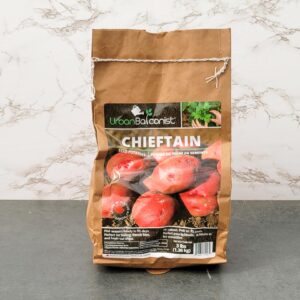

What does it mean to ‘Chit’ your potatoes?
Chitting is a very easy step you can take to give your seed potatoes a leg up for our short growing season. While not absolutely necessary to see success in growing your potatoes, we do recommend it –
Here is how you chit potatoes:
Let them sit in a bright (but not too hot) space such as on a windowsill. Allow the ‘chits’ or sprouts to grow to about 1″ in length prior to planting. You can cradle your seed potatoes in an egg carton to prevent them from rolling away. Place the end with the most eyes upward.
Potatoes are a robust and popular crop and they’re quite easy to grow if you follow a few key steps:
Determinate or Indeterminate?
Knowing which type of of plant you’re growing is helpful when attempting to care for them appropriately. The bag your seed potatoes came in should indicate which type the variety is. If not, a quick internet search of the variety name should tell you.
Determinate potatoes are simple, just bury the seed potato to the depth indicated on the package and allow the plant to grow.
Indeterminate varieties, however, need a bit of tending to. As the stem grows, hill up soil around the plant. Tubers will sprout along the stem into the new soil you add. Hilling up around the plant also keeps the sun from hitting the newly forming potatoes. If growing potatoes receive sunlight they will turn green and will no longer be suitable for eating.
Light: Potatoes will do best in a full sun location but will grow well in partly shaded areas also.
Water: Water as required to keep the plant from wilting. When you see flowers forming, that’s your indication to increase watering as it’s a clue about what’s happening below. Potatoes forming under the soil are incredible water storage tubers and if you want plump, juicy potatoes they’ll need adequate water.
Fertilizer: If your plants are in a good quality soil and the tops are growing well there is little need for extra fertilizer. In fact, too much nitrogen can encourage the plant to grow greens instead of tubers. Potato plants may benefit from Phosphorus applied as the flowers form which can result in higher tuber yields. We recommend organic bone meal.
With the potatoes growing underground, we all get a bit curious as to what’s going on in there. Should we dig them up? Or let them continue to grow? One clue should be on the package from your seed potatoes. It will tell you if they are an early or late harvest variety and how many days it will take for the tubers to grow. Early varieties like Warba and Caribe take about 70 days while some later varieties will need closer to 100. It’s best to write the information down somewhere safe when you plant them.

A tell tale sign that the spuds are ready to dig up is that the greens of the plant start to yellow and die back. Don’t be in a hurry though, leaving the spuds in the ground allows them to develop tougher skins which in turn allows them to store well. If you grow your potatoes in grow bags or buckets you can even store them in the soil, in the garage where they won’t freeze. Just remove the tops and drag your buckets inside as is!
Prefer to harvest early for those tender new potatoes? Just be sure to consume them quickly as they won’t keep as long without a developed skin.
Potato scab is a non-harmful fungus that exists in the soil, and it’s common in Alberta. It’s predominately found in former woodland areas that have been cleared for residential building, and thrives in neutral pH, nutrient-deficient soil. Here are some of the things you can do to combat potato scab:
1. Plant your potatoes with sulphur dust. Add some Garden Sulphur to a bag with your seed potatoes, and give them a good shake to make sure your seed potatoes are covered. Plant as normal. Sulphur helps to acidify the soil surrounding your potato plants, which will greatly reduce the amount of scab-causing fungus that survives. Plus, potato plants love acidic soil, so it’s a win-win.
2. Rotate your root veggies and your above-ground plants from season-to-season. These plants tend to use different sets of nutrients up from the soil, so by rotating them each season, you can help prevent your soil from becoming depleted and out-of-balance (an environment in which scab will thrive).
3. Amend your garden beds with organic nutrients such as compost, manure or sea soil. These amendments will add important macro and micronutrients back to the soil, and will support an ongoing bio-active environment that greatly benefits your plants, and discourages unwanted pests and fungus.
Can I Eat Potatoes with Scab?
The good news is that, while scabby potatoes might not look picture perfect, potatoes with scab are still edible! Scab won’t hurt you if you eat it, but it is corky and unappetizing, so most gardener’s will peel their scabby potatoes before consumption. It’s also good to know that scabby potatoes may not store for as long.
Growing potatoes is fun, easy and rewarding. There’s nothing like digging up treasure at the end of the gardening season! But there are a few things to take into consideration; chitting, planting and harvesting should be managed at several stages throughout the plants growth. If you watch for clues and signs the plants give – sprouting, flowering, wilting – you’ll have a good idea of what you need to do at any given time. Happy Growing!

We are Cochrane & West Calgary’s largest Garden Center, owned-and-operated by plant-loving locals. We’re glad you’re here. You can visit us 7 days a week in store, or online. Get Directions
Get free gardening resources, monthly coupons, and new arrival alerts, straight to your inbox.
Join Now